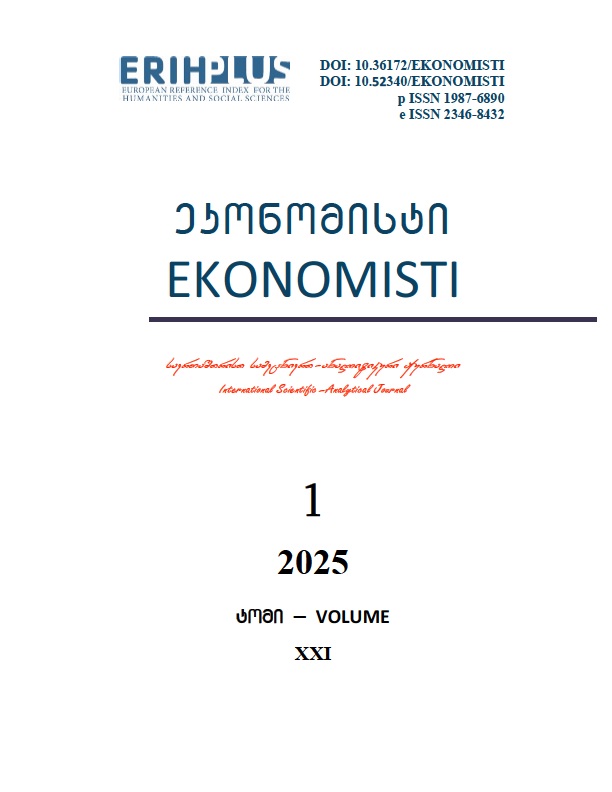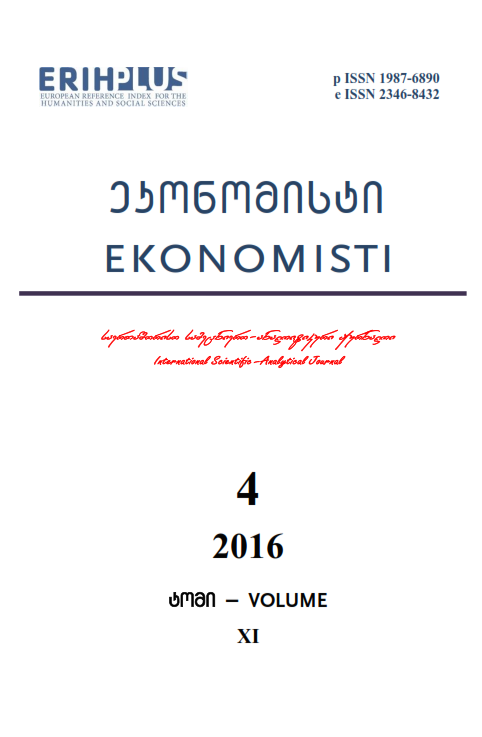
The international scientific and analytical, reviewed, printing and electronic journal of Paata Gugushvili Institute of Economics of Ivane Javakhishvili Tbilisi State University

THE IMPACT OF BUSINESS ENVIRONMENT ON THE STRUCTURAL LINK BETWEEN FIRMS INNOVATION, PRODUCTIVITY AND EXPORT PERFORMANCE IN TRANSITION ECONOMIES[1]
DOI: 10.36172/EKONOMISTI.2020.XVI.04.Berulava.Gogokhia
Expanded Summary
Innovation, productivity growth and exporting are important economic factors that many consider crucial to the economic development and enhancing living standards. The worldwide experience provides plenty evidence that innovation and export promotions are important components of the growth strategy in emerging markets. Discussions of factors that determine success of innovation and export performance have been ongoing for many years. Both the factors that are under the firm control and external factors have been studied extensively in the academic literature. However, the role of business environment as one of the external factors in promoting innovation, productivity and export performance of companies as well as the structural interrelationships between these factors remained relatively unstudied. This paper focuses on the role of the business environment in influencing innovation, productivity, and export performance of firms in transition economies.
In this study as a proxy for business environment we use we adopt a business environment reforms (BER) index from Gogokhia and Berulava (2020) study. The index has been calculated as the difference between subjective evaluations of business environment constraints for innovator and non-innovator firms aggregated (by country and size of locality). Various dimension of business environment are captured by the following BER indexes: the total index, the business/economic regulatory environment index, the infrastructural environment index and the political stability/legal environment index. The lower the value of the index, the better the environment for the innovative and productive activities of firms.
Rest upon the findings from the existing literature, we specify our expectations in the following research hypotheses:
- H1. The lower the business environment reforms index, the higher a firm’s extensive margin of R&D.
- H2. The lower the business environment reforms index, the higher the intensity of R&D activity of a firm.
- H3. The lower the business environment reforms index, the higher the probability that a firm is engaged in the innovation activity.
- H4. The lower the business environment reforms index, the higher the level of the labor productivity of a firm.
- H5. The lower the business environment reforms index, the higher the export propensity of a firm.
- H6. R&D has positive and significant impact on innovations.
- H7. Innovation has a positive and significant impact on a firm’s productivity.
- H8. Labor productivity of the firm has a positive and significant impact on its export propensity.
To attain the research goal, we apply an augmented CDM model (Crepon, Duguet, and Mairesse, 1998). The model includes five equations - R&D decision equation; R&D intensity equation, Innovation equation, productivity equation, and export equation - and is estimated sequentially or step-by-step. We test the effects of business environment reforms at each stage of the R&D-innovation-productivity-exporting structural link, by including the BER index in each of the consequent equations of the structural model.
The main source of the data for the research is the micro-level dataset from the fifth round of the Business Environment and Enterprise Performance Survey (BEEPS V).[2] The survey was conducted by the European Bank for Reconstruction and Development (EBRD) and the World Bank Group (World Bank) in the European and Central Asian region in the period of 2012-2014.
The results of our estimations suggest that business environment reforms represent an important external determinant of a firm’s innovative and productive performance in transition economies. Thus, the research hypotheses on the link between business environment reforms and a firm’s performance outcomes such as R&D and innovation, labor productivity as well as propensity to export, are generally proven. The results of the study suggest that better business environment stimulates firms to make decisions about investing in R&D, while it has no effect on the intensive margin of R&D. However, the study’s outcomes show that the patterns of the influence on a firm’s performance differs across the various dimensions of the business environment. One of the patterns assumes a two-fold effect of business environment reforms on propensity to export: indirect through stimulating a firm’s R&D and innovation performance, enhancing labor productivity and direct, probably through reducing transaction costs and the costs of doing business and enhancing governance structures. Such a pattern of the impact is characteristic for the total BER index and the business/economic regulatory environment reforms index. The reforms in the Political/ Legal environment, according to the current research, have no effect on R&D and the innovative activities of firms but they are important for enhancing a firm’s productivity. Also, the results of our study support early findings that R&D is an important determinant of innovation, innovation is a driver of labor productivity and that labor productivity substantially increases the probability of firm’s participation at export markets.
The main contribution of this study is that it provides new empirical insights into the structural relationship between business environment reforms and the innovation, productivity and export performance of firms in transition economies. The study’s results, generally, imply that business environment reforms, providing incentives for investing in knowledge, innovation activity and productivity enhancement in transition economies represents an important factor for a firm’s development.
[1] This research was supported by „Shota Rustaveli National Science Foundation of Georgia“ („SRNSFG“) [grant number №YS-18-1304].

